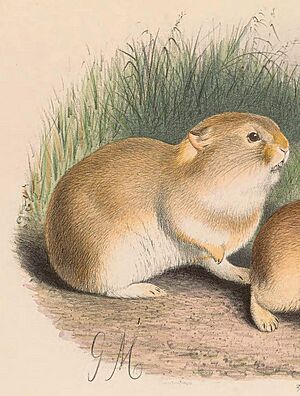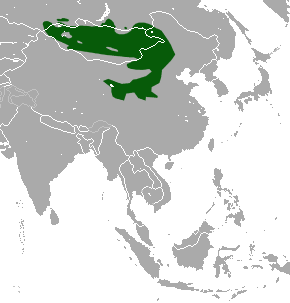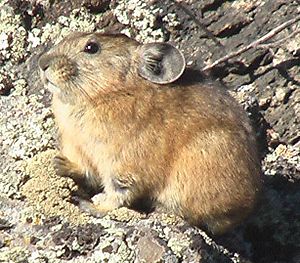Daurian pika facts for kids
Quick facts for kids Daurian pika |
|
|---|---|
 |
|
| Conservation status | |
| Scientific classification | |
| Genus: |
Ochotona
|
| Species: |
dauurica
|
 |
|
| Daurian pika range | |
The Daurian pika (Ochotona dauurica) is a small animal. It is related to rabbits and hares. These animals belong to a group called Lagomorpha.
Daurian pikas are famous for their "barking" alarm call. They also have a special way of preparing for winter. They make their own "hay" from plants to eat when food is scarce.
Like rabbits and hares, pikas have a second set of small front teeth. Both male and female Daurian pikas look alike. They have thick, reddish fur. Pikas do not have an outside tail, and their ears are big and round. These pikas are important to their environment. They are known as a keystone species. This means many other species depend on them.
Contents
Where Daurian Pikas Live
Daurian pikas live in many parts of Asia. You can find them in Mongolia, southern Russia, and parts of China. They prefer to live in mountains and grasslands.
Their Mountain Homes
These pikas live at different heights in the mountains. They can be found from 400 to 4,000 meters above sea level. They like desert grasslands. Here, they can dig burrows to stay safe in winter. They also find fresh grass to eat.
Sometimes, Daurian pikas share their burrows. They might live with Campbell's dwarf hamsters. This happens in the steppes and semi-deserts of northern Manchuria.
All About Pika Families
Pikas first appeared a very long time ago. Their fossils show up in records from the late Miocene period. They started in central Asia. Rivers and glaciers helped them spread out. This led to the 30 different pika species we know today.
Pikas and Their Relatives
Pikas are mammals. They belong to the order Lagomorpha. This group has two main families alive today. One is Leporidae, which includes rabbits and hares. The other is Ochotonidae, which is just for pikas.
There is only one main group, or genus, of pikas called Ochotona. Daurian pikas are part of this group. You can tell Daurian pikas apart from other pikas. They have a specific home range, different social habits, and their reddish fur.
How Daurian Pikas Live
Daurian pikas are active during the day. They eat many different kinds of plants. They usually walk around, but they also dig burrows. This means they spend time both above and below ground.
Making Hay for Winter
Daurian pikas are special because they make hay together. In summer, they eat grasses. In late summer and early autumn, they gather other plants. These plants are rich in fats and proteins. They store these plants above ground near their shared burrows. The plants dry out and become hay. This hay helps them survive the cold winter months.
They build about 10 hay piles for each burrow system. These hay piles are super important for their survival. It is thought that only about one-third of pikas survive winter if they have enough food. If their hay piles are taken away, very few survive.
Pika Babies and Communities
Because many pikas do not survive winter, they need to have many babies. They can have several litters of babies each year. A single litter can have up to 11 young pikas! Pikas born early in the year can even have their own babies before summer ends.
Daurian pika communities are spread out. There are about 0.3 to 0.5 active burrows in an area the size of a football field.
Pikas and Other Animals
Daurian pikas sometimes share their burrows. They have been seen visiting the burrows of marmots and other pikas. Other animals also visit pika burrows. Ground squirrels and some burrowing birds might use them.
Pika populations are mostly limited by winter. They do not have many animals competing for food. They also do not have many predators.
Protecting Daurian Pikas
In the past, farmers thought Daurian pikas were pests. They believed pikas ate the same food as their farm animals. So, farmers tried to control pika numbers.
However, scientists have found that pikas eat different plants than farm animals. This means they are not actually pests! Efforts are now being made to teach local farmers this fact. Because of this, pika hunting is decreasing.
The Daurian pika is listed as a species of "least concern." This means they are not currently in danger of disappearing. But, some groups of pikas near the Gobi desert might be at risk.
See also



